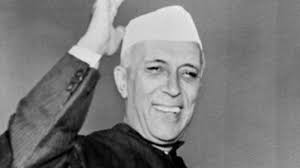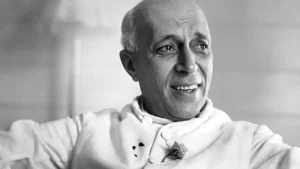Introducing Planning in Cities
To build a city is something happy to think of. To create a new town is itself a happy thing. There cannot be a greater joy than to create. it is almost godlike to create. To be associated, therefore, with the construction of a city has been a thing which I appreciate the most.
The construction of the capital is not one of putting up buildings here and there. In the construction we should think of the type of life we want to provide to the community. We have to think of the many aspects of the life of the city. Anything that we build should be of beauty but it should not be costly. In New Delhi, there are expensive and costly buildings, but they are not beautiful. In India we lost our ancient art during foreign domination. Unfortunately most of the people, especially artisans, lost their sense of art and designs.
The sense of beauty has an important role to play on the minds of the young generation. So the new city should be a place of beauty, developing ideas of beauty and everything that should be good so that life might become an adjunct to beauty.
What I should like in regard to every city is a clear plan of what the city will be like, say, twenty or thirty years later. And then you can work by that plan slowly, gradually. Nothing should be allowed to come in the way of that plan, as has happened, for example, in our city of Delhi. Amazing structures have been put up in a haphazard manner all over Delhi and they come in our way now and in future..
Every extension of the city beyond its present inhabited limits means new roads, lighting arrangements, water supply, road water ing, sanitation etc. each involving heavy expense. An improvement scheme must therefore avoid this heavy expenditure as far as possible and should take advantage of existing roads. The Trust should aim at a sub-division of the existing large compounds so as to reduce them as far as possible to one acre or less.
Large compounds are bad for the city and bad for Municipality. If any one wants to keep a large compound he must pay for the luxury.
big buildings cost money. But a touch of artistry does not cost money, or costs very little. It really needs some imagination and some love of beauty in the men who build them.
You can make the humblest cottage attractive and beautiful even though it might be a mud cottage, and you can make a big palace a thing of horror.
Bhubaneswar/New Capital of Orissa
It is my pleasure, my privilege and my pride today, the 13th April 1948, to declare that the foundation stone of this capital town of Bhubaneswar has now been well and truly laid under these favourable auspices supported with the goodwill of each of you assembled here at this morning gathering. Jai Hind
The laying of the foundation stone of the capital city of Bhubaneswar turned out to be more exciting than I had thought. The site is an ideal one, undulating ground and a cool breeze coming from the sea. The past is represented by ancient temples, some of them famous for their architecture and artistry. Otherwise, there is a clean slate to write upon. The architect and the chief engineer have thought of this future city in terms not of a few palatial buildings but of a happy community.
The capital is planned to help the people who have to live and work and play there. It will be, I hope, a pleasant city with attractive buildings. First attention has been paid to the health, safety and education of the children, and their schools and playgrounds have been especially laid out with this object in view.
The new town will be grouped in self-contained neighbourhood units, each comprising about 850 families. This will enable the town to grow without losing its community and neighbourly character. In each area residential houses will surround the schools and shopping centres and will be near to open fields and recreation grounds. In the centre of the town will be a group of public buildings with a Gandhi Memorial Pillar symbolising the life and teachings of Gandhiji. The new city is fortunate in having an architect of vision and engineers of both vision and capacity, and its growth will be watched with great interest.
Unlike New Delhi which was meant to impress people with the might of an empire and which has no real contact with the common people, this new capital’s plan has been such as to maintain contact with the masses and in the new capital the first thought has been given to children how they should live and receive education, to women workers and labourers.
The new capital will not be a city of big buildings for officers and rich men without relation to the common masses. It will accord with our idea of reducing differences between the rich and the poor.
I hope that people of this province will remain in peace despite differences of religion and caste and that the new capital will blossom into a city where the common people will enjoy a real life.
I have come to Orissa to inaugurate the Hirakud Dam. When the Project is fully executed, it will change the whole picture of the province of Orissa. It is to me a symbol not only of a new Orissa but also of a new India in the constructive field. The laying of the foundation stone of this new city has been a task after my heart. Construction is always welcome.
We have much of art in Orissa and the designs with colours painted on houses in Orissa are some of the finest in India.
I have just come back after a brief two-day visit to Orissa. I went there to inaugurate the construction of the Hirakud Dam and to lay the foundation stone of the new capital of Orissa at Bhubaneswar The two days were full of work and engagements, but I had a sense. of peace there which I had not experienced for a considerable time. The atmosphere of Orissa was very different from the turgid, conflict-laden air of Delhi and of so many other places in India today.
Chandigarh
India has many famous ancient cities and buildings. Among these reminders of the past, there now stands a new and utterly different, growing city-Chandigarh, which is, in the main, the creation of the famous architect, Le Corbusier. I think, however, that Chandigarh is a great creation, which has already powerfully affected Indian architecture and brought new and fascinating ideas to our architects and town planners.
Let this be a new town symbolic of the freedom of India, unfettered by the traditions of the past… an expression of the nation’s faith in the future.
I have welcomed very greatly one experiment in India. Chandigarh. Many people argue about it, some like it, and some dislike it. It is the biggest example in India of experimental architecture. It hits you on the head, and makes you think. You may squirm at the impact but it has made you think and imbibe new ideas, and the one thing which India requires in many fields is being hit on the head so that it may think. I do not like every building in Chandigarh. I like some of them very much. I like the general conception of the township very much but, above all, I like the creative approach, not being tied down to what has been done by our forefathers but thinking in new terms, of light and air and ground and water and human beings. Therefore, Chandigarh is of enormous importance.
Chandigarh is gradually taking shape. It is fascinating to see this new city rising up. Thus far, not many buildings have been put up and the place does not resemble a city but has rather a number of isolated buildings. But even these buildings are cunningly devised and branch off, in many ways, from the static conceptions of architecture to which we have been accustomed. I have no doubt that Chandigarh is going to influence our buildings all over India in future.
Recently I visited the Bhakra-Nangal project in the Punjab and Chandigarh, where the new capital of the Punjab is growing up. This visit impressed me greatly. The engineering feats at Bhakra Nangal are remarkable. The whole of the Punjab and part of Rajputana and some other places are looking forward to the life giving water that will come from the Sutlej river through the new canals that are being dug. Also, hydro-electric power will be produced and industries will grow.
Chandigarh promises to be a model and attractive city, combining the best features of the East and the West. A very eminent French architect, Monsieur Le Corbusier, is in-charge from the architectural point of view.
There is no doubt that Le Corbusier is a man with powerful and creative type of mind. For the same reason, he may produce extravagances occasionally but it is better to be extravagant than be a person with no mind at all.
The social functions of today bear on our architecture. We may not, even if we have the capacity, build a Taj Mahal. It does not fit in with the society of today. In the ultimate analysis a thing which fits in with the social functions is beautiful.
The proposal of Le Corbusier to have a special type of museum [as] a display of scientific progress and of electronic devices appears to me a very attractive one. It would be unique in India and will give us a glimpse of the future.










